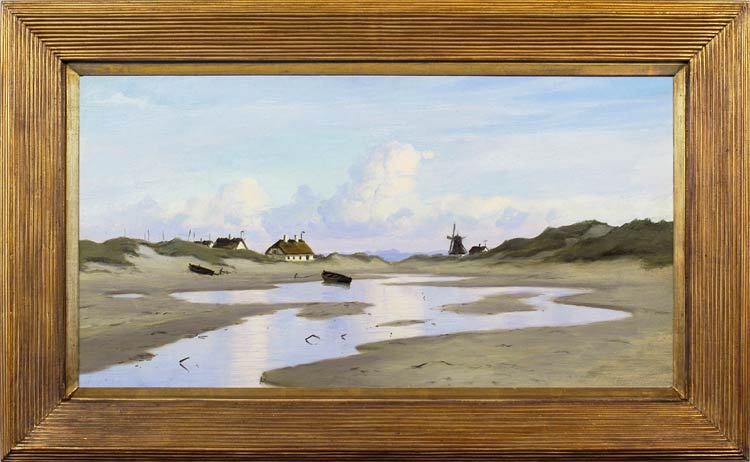A characteristic but particularly lovely example of Olsen’s coastal paintings, in his preferred extended horizontal format, this panoramic sweep of dunes around an estuary or inland pool radiates a profound tranquillity. It may have been painted near Skagen, which was noted for its artists’ colony in the late 19th century, as well as for its clusters of low fishermen’s cottages with their disproportionately large roofs – just as Olsen has depicted them in this landscape. Skagen is sited at the end of a peninsular at the northern tip of Denmark, allowing for constantly varying conditions of light, weather and tide, all of which would have appealed to Olsen, with his sensitivity to the effects of climate and time of day. It also boasts a windmill very similar to that shown in his painting. The composition, with its large areas of sky and water, emphasize the clarity of light for which Skagen was famous, and contribute to the serenity of the work. The evidence of human life is diminished in comparison, but fits comfortably into the natural world – cottages, windmill and beached rowing boats indicating a life tied intimately to the elements.
Biographical details
Very little is known about Alfred Olsen, save that he was born in Fejo in Denmark in 1854; that he studied with Jens Jorgen Jensen-Egeberg (1848-1922); and that he made a living as a painter of marines in Copenhagen (Benezit). Jensen-Egeberg taught at the Royal Academy of Art in Copenhagen; he produced landscapes which were the equivalent of Olsen’s seascapes, where the Scandinavian sky, full of light and high cloud, filled the greater part of the painting. Olsen’s work seems only peripherally to admit the existence of the land, but his skies show that he had absorbed much from the teacher who was only six years his elder. The absence of public record of his work and of the artist himself is a testimony, as with so many ‘neglected’ artists, to a great popularity at a domestic level, such that these works tend to stay in the homes which appreciate them and do not often emerge onto the market.


